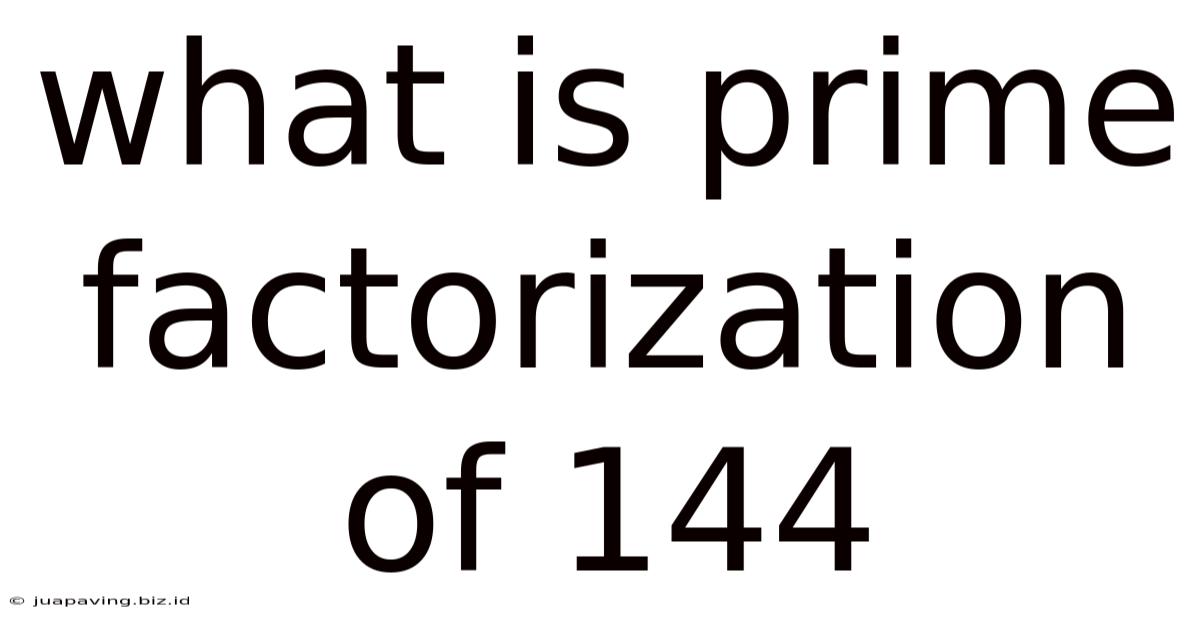What Is Prime Factorization Of 144
Juapaving
May 13, 2025 · 4 min read

Table of Contents
What is Prime Factorization of 144? A Deep Dive into Number Theory
Prime factorization, a fundamental concept in number theory, forms the bedrock of many mathematical operations and cryptographic systems. Understanding prime factorization allows us to simplify complex numbers, analyze their properties, and even solve seemingly intractable problems. This article delves into the prime factorization of 144, providing a comprehensive explanation of the process, its applications, and related concepts.
Understanding Prime Numbers and Factorization
Before we tackle the prime factorization of 144, let's establish a solid foundation. A prime number is a whole number greater than 1 that has only two divisors: 1 and itself. Examples include 2, 3, 5, 7, 11, and so on. Numbers that are not prime are called composite numbers.
Factorization, on the other hand, is the process of breaking down a composite number into its constituent prime numbers. This process is unique for every composite number, meaning there's only one way to express a number as a product of prime factors (ignoring the order). This uniqueness is crucial in various mathematical applications.
Finding the Prime Factorization of 144
Now, let's find the prime factorization of 144. We can use a method called the factor tree. This involves repeatedly dividing the number by its smallest prime factor until we're left with only prime numbers.
Here's how we can do it for 144:
-
Start with 144: 144 is an even number, so its smallest prime factor is 2.
-
Divide by 2: 144 ÷ 2 = 72.
-
Continue dividing by 2: 72 ÷ 2 = 36; 36 ÷ 2 = 18; 18 ÷ 2 = 9.
-
Now we have 9: 9 is not divisible by 2, but it is divisible by 3.
-
Divide by 3: 9 ÷ 3 = 3.
-
We're left with 3: 3 is a prime number.
Therefore, the prime factorization of 144 is 2 x 2 x 2 x 2 x 3 x 3, or 2<sup>4</sup> x 3<sup>2</sup>.
Visualizing the Factor Tree
A factor tree visually represents this process:
144
/ \
2 72
/ \
2 36
/ \
2 18
/ \
2 9
/ \
3 3
This tree clearly shows how we repeatedly divided 144 until we reached only prime numbers at the bottom.
Applications of Prime Factorization
The seemingly simple process of prime factorization has surprisingly broad applications across various fields:
1. Simplifying Fractions:
Prime factorization is essential for simplifying fractions to their lowest terms. By finding the prime factors of both the numerator and the denominator, we can identify common factors and cancel them out. For instance, simplifying 144/72 would be significantly easier with the knowledge of their prime factorizations.
2. Finding the Greatest Common Divisor (GCD) and Least Common Multiple (LCM):
The GCD and LCM of two or more numbers are crucial in various mathematical operations. Prime factorization provides an efficient method for determining both. The GCD is the largest number that divides both numbers without leaving a remainder, while the LCM is the smallest number that is a multiple of both numbers.
3. Cryptography:
Prime factorization plays a vital role in modern cryptography, particularly in the RSA algorithm. This algorithm relies on the difficulty of factoring very large numbers into their prime factors. The security of many online transactions depends on the computational intractability of this problem for large numbers.
4. Modular Arithmetic:
Modular arithmetic is a system of arithmetic for integers, where numbers "wrap around" upon reaching a certain value, called the modulus. Prime numbers and their properties are fundamental to understanding and working with modular arithmetic, which is extensively used in cryptography and computer science.
5. Number Theory:
Prime factorization is a central concept in number theory, a branch of mathematics concerned with the properties of integers. Many number-theoretic theorems and conjectures revolve around prime numbers and their distributions.
Beyond 144: Exploring Other Factorizations
Let's briefly explore the prime factorizations of some numbers related to 144:
- 12: 12 = 2² x 3
- 24: 24 = 2³ x 3
- 72: 72 = 2³ x 3²
- 1440: 1440 = 2<sup>5</sup> x 3² x 5
Notice the relationships between these factorizations. They demonstrate how the prime factorization of a number can reveal connections to other numbers.
Advanced Techniques for Large Numbers
For larger numbers, the factor tree method can become cumbersome. More sophisticated algorithms, such as the Sieve of Eratosthenes and various factorization algorithms (like Pollard's rho algorithm, quadratic sieve, and general number field sieve), are employed to efficiently factorize large numbers. These algorithms leverage advanced mathematical concepts and are crucial for the security of cryptographic systems.
Conclusion
The prime factorization of 144, 2<sup>4</sup> x 3<sup>2</sup>, is more than just a simple mathematical result. It's a gateway to understanding the fundamental building blocks of numbers and their profound applications in various fields. From simplifying fractions to securing online transactions, the concept of prime factorization underscores the power and elegance of number theory. Mastering this concept provides a solid foundation for further exploration of more advanced mathematical topics and their real-world applications. The seemingly simple act of breaking down a number into its prime factors reveals a deep mathematical structure with far-reaching implications.
Latest Posts
Latest Posts
-
How Many Litres Is 3 Gallons
May 14, 2025
-
What Are A Group Of Fish Called
May 14, 2025
-
Five Letter Words That End With On
May 14, 2025
-
How Many Glass Is 1 Liter Of Water
May 14, 2025
-
Words That End With I N G
May 14, 2025
Related Post
Thank you for visiting our website which covers about What Is Prime Factorization Of 144 . We hope the information provided has been useful to you. Feel free to contact us if you have any questions or need further assistance. See you next time and don't miss to bookmark.